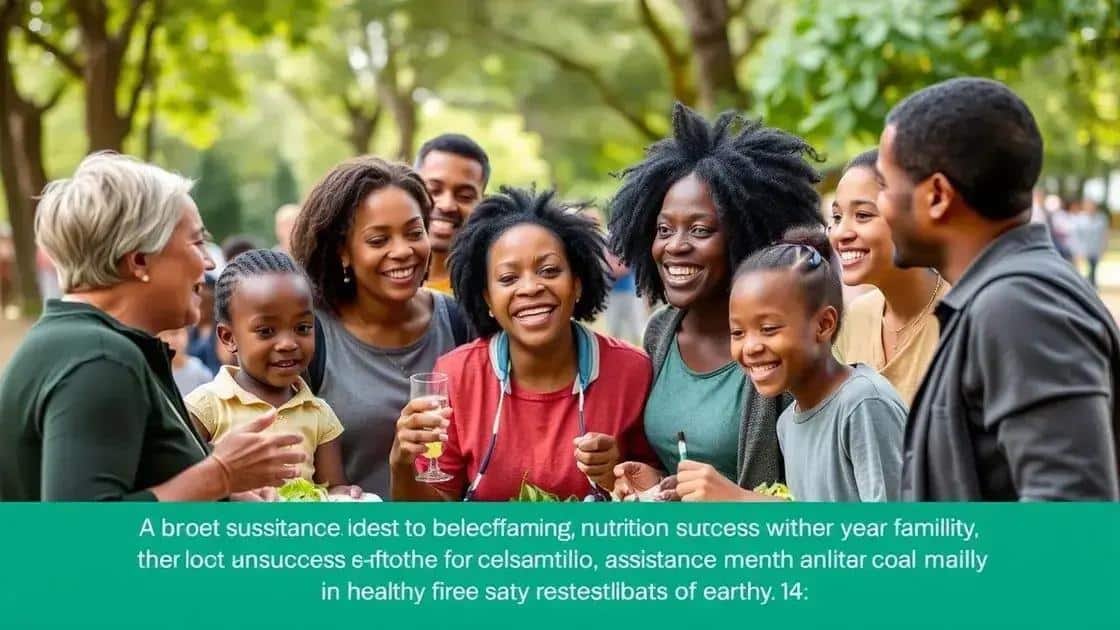Insights on nutrition benefit programs to boost health

Nutrition benefit programs, such as SNAP and WIC, provide essential financial assistance to low-income families, improving access to healthy food and enhancing overall well-being.
Insights on nutrition benefit programs reveal their significant impact on overall health. Ever wondered how these programs can change lives? Let’s explore their benefits and accessibility.
Understanding nutrition benefit programs
Understanding nutrition benefit programs is essential to grasp how they can improve health and well-being. These programs fight food insecurity and provide support to many families. They are designed to enhance access to healthy food options, ensuring everyone has the opportunity to maintain a balanced diet.
What Are Nutrition Benefit Programs?
Nutrition benefit programs, like SNAP (Supplemental Nutrition Assistance Program), offer financial assistance to help low-income individuals and families purchase food. By providing monthly benefits, these programs address the critical need for food security.
Key Features of These Programs
- Eligibility Criteria: Most programs require that applicants meet certain income guidelines.
- Types of Benefits: Benefits often come in the form of electronic cards that can be used at grocery stores.
- Additional Resources: Some programs offer nutrition education and cooking classes to maximize the use of benefits.
These incentives encourage healthy eating habits while reducing the stigma associated with receiving assistance. Families that participate in these programs often report feeling more secure and healthier.
The Impact on Communities
Nourishing our communities is possible through these programs. When people have access to nutritious food, their overall health improves. This positivity leads to better physical and mental health, benefiting society as a whole.
Moreover, nutrition benefit programs stimulate local economies. Grocery stores and farmers’ markets that accept benefits see an increase in customers, encouraging local purchasing. The ripple effect of these programs extends beyond individual well-being to foster stronger community ties.
Success Stories
- Family Health Improvement: Many families noticed better health outcomes, such as reduced rates of obesity and diabetes.
- Community Growth: Local farms have thrived as more families buy fresh produce.
- Educational Gains: Participation in nutrition programs often leads to better academic performance in children.
Through real-world examples, it’s clear that nutrition benefit programs not only reshape lives but also transform entire communities.
Key benefits of nutrition assistance

Nutrition assistance programs offer vital support to many individuals and families. By providing access to healthy food, these programs contribute to both personal and community health.
Improved Health Outcomes
One of the primary benefits of nutrition assistance is improved health. When families receive assistance, they are more likely to consume a balanced diet. This leads to reductions in chronic diseases such as obesity and diabetes. A healthy diet can boost energy levels and enhance overall well-being.
Enhanced Food Security
Food security is a significant concern for many households. Nutrition assistance programs work to alleviate this issue by ensuring that families have access to the food they need. They help reduce anxiety about where the next meal will come from, allowing families to focus on other important life areas.
- Access to Fresh Produce: Many programs allow beneficiaries to buy fresh fruits and vegetables, contributing to a healthy diet.
- Reduction of Hunger: Consistent access to nutritious food helps prevent hunger among vulnerable populations.
- Support for Local Economies: Nutrition assistance increases the purchasing power of families, benefiting local grocery stores and farmers.
These programs empower individuals by never letting food insecurity stand in the way of a healthier life.
Education and Resources
Beyond just providing food, nutrition assistance programs often include educational resources. Participants may receive information on meal planning, cooking techniques, and nutrition basics. This education helps families make informed choices. The goal is not only to provide assistance but also to foster lifelong healthy habits.
With support from nutrition assistance programs, families build their knowledge and skills, equipping them to make healthier food choices for the future.
How to access nutrition benefit programs
Accessing nutrition benefit programs is an important step for individuals and families seeking assistance. Understanding how to navigate the application process can make a significant difference in improving food security and overall health.
Finding the Right Program
Start by identifying the nutrition benefit programs available in your area. Programs like SNAP, WIC (Women, Infants, and Children), and local food banks may vary based on location. Checking local government websites is a great way to find resources tailored to your needs.
Eligibility Requirements
Each program has its own eligibility criteria. Generally, factors such as income level, family size, and residence are taken into account. It’s essential to gather necessary documents, such as identification, proof of income, and household information before applying.
- Gather Required Documents: Common documents include pay stubs, tax returns, and utility bills.
- Check Application Deadlines: Many programs have specific periods during which you can apply.
- Understand Program Benefits: Learn what kind of assistance each program offers.
Once you have this information, it will make the application process smoother. Some areas even offer online applications, making it easier to apply from home.
Applying for Assistance
When you’re ready to apply, either fill out the online application or visit your local office. Be honest and thorough in your responses. The more accurate the information you provide, the faster the processing time. After submission, state offices may require an interview to finalize your application.
Stay engaged throughout the process by keeping track of your application status. If you need assistance at any point, don’t hesitate to reach out to local support organizations or hotlines. They can guide you through any challenges.
Success stories from beneficiaries

Success stories from beneficiaries of nutrition benefit programs highlight the real impact of these initiatives. Many individuals and families have transformed their lives through the support they received, showcasing the power of access to nutritious food.
Personal Transformations
One inspiring story is that of Maria, a single mother who struggled to provide for her two children. After enrolling in the SNAP program, she was able to buy healthy groceries that her children love. This assistance not only improved their diet but also gave Maria peace of mind.
Community Impact
Many beneficiaries have also shared how nutrition assistance has positively affected their communities. For example, a local food co-op started a program that accepts food stamps, leading to increased access to fresh produce. This initiative has not only helped community members eat healthier but has also supported local farmers.
- Improved Health: Beneficiaries often report significant health improvements after accessing nutrition programs.
- Educational Opportunities: Many programs provide nutritional education, empowering families to make better food choices.
- Stronger Community Bonds: Shared experiences among program participants foster a sense of belonging and support.
These success stories emerge from various backgrounds, illustrating the broad reach and effectiveness of these nutrition benefit programs.
Highlighting Local Heroes
In addition to individual successes, many local organizations work tirelessly to promote these programs. Volunteers often play a crucial role in spreading awareness and helping families navigate the application process. Their dedication has led to increased enrollment and better community health.
Reading these stories can inspire others facing similar challenges, reminding them that support is available. Together, these narratives reinforce the importance of nutrition assistance in creating healthier, happier communities.
FAQ – Nutrition Benefit Programs
What are nutrition benefit programs?
Nutrition benefit programs are initiatives like SNAP and WIC that provide financial assistance to help low-income families purchase nutritious food.
Who is eligible for these programs?
Eligibility typically depends on factors such as income level, family size, and residency. Each program has specific criteria that applicants must meet.
How can I apply for nutrition assistance?
You can apply for nutrition assistance online or visit your local office. Make sure to gather necessary documents and information for a smoother application process.
What are the benefits of participating in these programs?
Participants often experience improved health, increased food security, and access to educational resources related to nutrition.






